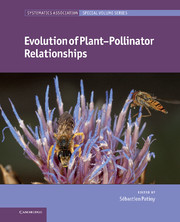Book contents
- Frontmatter
- Contents
- Contributors
- Preface
- 1 Macroevolution for plant reproductive biologists
- 2 Pollination crisis, plant sex systems, and predicting evolutionary trends in attractiveness
- 3 Evolution and ecological implications of “specialized” pollinator rewards
- 4 Fig–fig wasp mutualism: the fall of the strict cospeciation paradigm?
- 5 Fossil bees and their plant associates
- 6 Pollen evidence for the pollination biology of early flowering plants
- 7 Pollinator mediated floral divergence in the absence of pollinator shifts
- 8 Animal pollination and speciation in plants: general mechanisms and examples from the orchids
- 9 Why are floral signals complex? An outline of functional hypotheses
- 10 A survey on pollination modes in cacti and a potential key innovation
- 11 Zygomorphy, area, and the latitudinal biodiversity gradient in angiosperms
- 12 Ambophily and “super generalism” in Ceratonia siliqua (Fabaceae) pollination
- 13 Structure and dynamics of pollination networks: the past, present, and future
- 14 Pollinators as drivers of plant distribution and assemblage into communities
- 15 Effects of alien species on plant–pollinator interactions: how can native plants adapt to changing pollination regimes?
- 16 Pollen resources of non-Apis bees in southern Africa
- 17 Advances in the study of the evolution of plant–pollinator relationships
- Index
- Plate section
- References
15 - Effects of alien species on plant–pollinator interactions: how can native plants adapt to changing pollination regimes?
Published online by Cambridge University Press: 05 January 2012
- Frontmatter
- Contents
- Contributors
- Preface
- 1 Macroevolution for plant reproductive biologists
- 2 Pollination crisis, plant sex systems, and predicting evolutionary trends in attractiveness
- 3 Evolution and ecological implications of “specialized” pollinator rewards
- 4 Fig–fig wasp mutualism: the fall of the strict cospeciation paradigm?
- 5 Fossil bees and their plant associates
- 6 Pollen evidence for the pollination biology of early flowering plants
- 7 Pollinator mediated floral divergence in the absence of pollinator shifts
- 8 Animal pollination and speciation in plants: general mechanisms and examples from the orchids
- 9 Why are floral signals complex? An outline of functional hypotheses
- 10 A survey on pollination modes in cacti and a potential key innovation
- 11 Zygomorphy, area, and the latitudinal biodiversity gradient in angiosperms
- 12 Ambophily and “super generalism” in Ceratonia siliqua (Fabaceae) pollination
- 13 Structure and dynamics of pollination networks: the past, present, and future
- 14 Pollinators as drivers of plant distribution and assemblage into communities
- 15 Effects of alien species on plant–pollinator interactions: how can native plants adapt to changing pollination regimes?
- 16 Pollen resources of non-Apis bees in southern Africa
- 17 Advances in the study of the evolution of plant–pollinator relationships
- Index
- Plate section
- References
Summary
Introduction
Invasive alien species are a major concern in the management and conservation of habitats and species worldwide (Crooks 2002; Bax et al. 2003; Levine et al. 2003; Vilà et al. 2010). The direct effects of these species may further cascade in the ecosystem and affect inter- and intraspecific ecological interactions. The introduction of alien plants and animals can have severe consequences, not only for individual native plant and pollinator species, but also for their ecological interactions through plant–pollinator networks (Morales and Traveset 2009; Dohzono and Yokoyama 2010; Schweiger et al. 2010). Integration of alien plant and pollinator species into pollination networks inevitably creates new interactions and may also affect the strength and quality of existing ones. These changes are open niches for novel evolutionary adaptations of both alien and native species (Mooney and Cleland 2001). However, research in this topic is very limited, and has focused mostly on adaptations of alien plant species to pollinator-independent reproduction modes (Barrett et al. 2008). We know of no study investigating adaptations of native plant and pollinator species to invaders, and the ecological and possibly evolutionary consequences of these adaptations in the context of plant–pollinator networks. Such adaptations might have far-reaching ecological and evolutionary implications, as has been shown in plant–herbivore and predator–prey interactions (Cox 2004). Here we outline the main effects of species invasions on plant–pollinator interactions, and deduce the main adaptive mechanisms that native plant species can exhibit in response to changes in their pollination regime. Finally, we explore the characteristics of plant populations that are likely to affect their probability of exhibiting such adaptations and their conservation implications.
Effects of alien plant and animal species on native plant pollination
Several groups of alien organisms have been shown to affect native plant pollination. Most research has focused on alien plants (Morales and Traveset 2009) and flower visitors (Lach 2003; Dohzono and Yokoyama 2010); however, other groups, such as alien herbivores and predators, can also be influential (Traveset and Richardson 2006). In the following, we explore the possible effects of different groups of alien organisms on pollination of native plants.
- Type
- Chapter
- Information
- Evolution of Plant-Pollinator Relationships , pp. 414 - 438Publisher: Cambridge University PressPrint publication year: 2011
References
- 1
- Cited by

